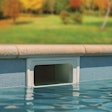
In today's society most people are looking for any chance to save a little green, so Pacific Gas & Electric (PG&E) in California conducted a study a few years back on the efficiency of automatic pool cleaners to help pool owners save a couple of bucks (and the state of California a couple of power plants.) What they found is that potentially pool owners could be saving anywhere from 1,478 to 2,792 kWh per year. At 30 cents per kWh that comes out to about $443 to $837 per annum, keeping in mind that 30 cents is on the higher end of the national average.
"We believed that robotic cleaners would use less electric energy than hydraulic cleaners, so the purpose of the study was to find out how much energy each needed to do the job," says Gary Fernstrom, one of the conductors of the study and a retired PG&E employee. "We also expected differences in efficiency between different types and brands of cleaners."
Fernstrom, along with Alina Zohabrian and Lianne Williams, ran several different automatic pool cleaners in the same standard size pool to see how efficiently they would run in regards to the cost of energy.
What the study found is that low-speed pumping saves energy, period. And the slower you can do it, the better. If you have to jack up your pump speed to run your hydraulic cleaner, that is going to waste energy. So for optimal energy consumption, keep your variable- or two-speed pump on a low setting and toss in your robotic cleaner.
And if you can't take advantage of low-flow filtration pumping, if you're stuck using a higher horsepower single-speed pump running at 3,450 rpm, well, forget it. You can't save any money with a robotic cleaner under those circumstances.
"It's important to point out that capturing the benefit relies on the cleaner being used with a variable- or two-speed pump," Fernstrom says. "If it's a single-speed pump, you might as well stay with the others."
The study also found that a ¾-horsepower booster pump proved to be the worst as far as energy cost efficiency goes. However, Fernstrom was very quick to point out that they were testing solely for cost efficiency, not performance and ability.
"We wanted to make adjustments for how well each cleaner did its job, but it was very difficult to account for that," Fernstrom says.
The team tried creating mathematical equations to account for different size pools, but that still left the question of how much debris was picked up by each cleaner, something that varied greatly between the different types. So in the end, the test results were open ended about which cleaner was "the best" even though they were very telling about the amount of energy each used.
While there is no measurable data to determine the impact of this study on pool owners in particular, Fernstrom has noticed the increasing marketing exposure of robotic cleaners.
"Retailers need to know two things when it comes to this topic," Fernstrom says. "One, hydraulic cleaners and booster cleaners are usually going to be sold through the maintenance guy, whereas robotic cleaners can be bought anywhere — WalMart, small retailers or the Internet. And two, the pool guy doesn't want any changes that they think might make the cleaning job more difficult, and as such a majority of them don't care for the robotic cleaners."
It seems that ultimately the best cleaner choice comes down to the pool owner and his maintenance pro balancing a number of factors, including operational considerations, how much it costs to run the automatic pool cleaner and how effective the cleaner is at doing its job.











































